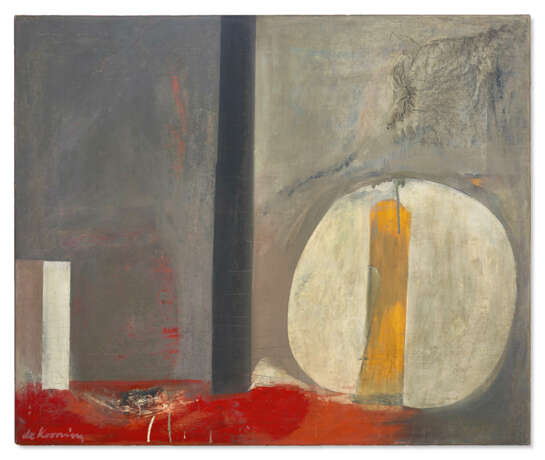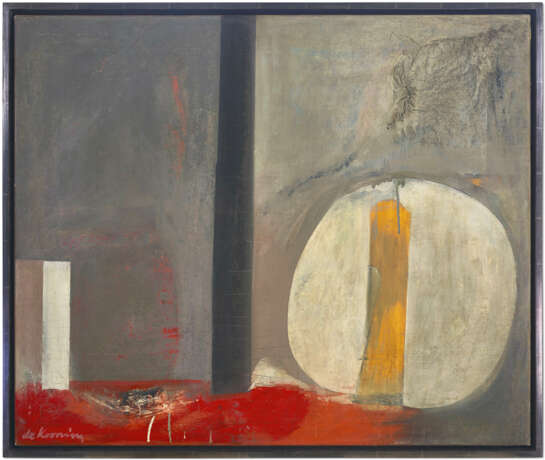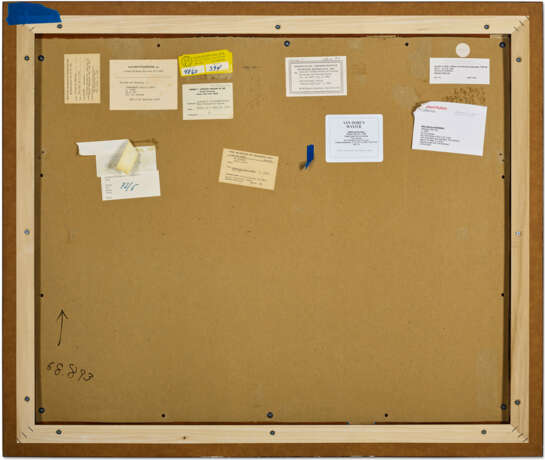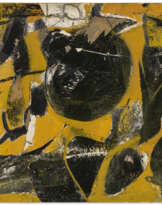ID 1031544
Lot 147 | WILLEM DE KOONING (1904-1997)
Valeur estimée
$ 200 000 – 300 000
Abstract Still Life
signed 'de Kooning' (lower left)
oil on canvas
30 x 36 in. (76.2 x 91.4 cm.)
Painted circa 1938.
Provenance
Collection of Mr. Daniel Brustlein and Mrs. Janice Biala Brustlein, Paris and New York, acquired directly from the artist, circa 1940
By descent from the above to the present owner, 2000
Literature
T. B. Hess, Willem de Kooning, New York, 1959, pp. 16-17 and 26, pl. 47 (illustrated).
G. Drudi, Willem de Kooning, Milan, 1972, p. 32, pl. 4 (illustrated).
H. Rosenberg, de Kooning, New York, 1973, n.p., pl. 9 (illustrated).
S. Yard, Willem de Kooning: The First Twenty-Six Years in New York, 1927-1952, New York and London, 1986, n.p., no. 32 (illustrated).
D Waldman, Willem de Kooning, New York, 1988, pp. 28-29, 50 and 153, no. 16 (illustrated).
Exhibited
New York, M. Knoedler & Co., Space and Dream, December 1967, p. 39 (illustrated).
Amsterdam, Stedelijk Museum; London, The Tate Gallery; New York, The Museum of Modern Art; The Art Institute of Chicago and Los Angeles County Museum of Art, Willem de Kooning, September 1968-September 1969, pp. 28, 46 and 160 (illustrated).
Ithaca, Herbert F. Johnson Museum of Art, Cornell University; Tokyo, The Seibu Museum of Art and New York, Whitney Museum of American Art, Abstract Expressionism: The Formative Years, March-December 1978, p. 6, pl. 53 (illustrated).
Städtische Kunsthalle Düsseldorf, 2 Jahrzehnte Amerikanische Maleriei, 1920-1940, June-August 1978, p. 155, no. 144 (illustrated).
Pittsburgh, Museum of Art, Carnegie Institute, Pittsburgh International Series: Willem de Kooning, October 1979-January 1980, pp. 32 and 168, no. 1 (illustrated).
New York, Mitchell-Innes & Nash, Garden In Delft: Willem de Kooning Landscapes 1928-88, May-June 2004.
Fort Worth, Amon Carter Museum and Andover, Addison Gallery of American Art, American Vanguards: Graham, Davis, Gorky, de Kooning and Their Circle, 1927-1942, June-December 2012.
New York, Leonard Hutton Galleries, The Irascibles and the New York School, March-May 2013.
Further details
Among Willem de Kooning’s earliest patrons were the painters Janice Biala and her husband Alain 'Daniel' Brustlein. Janice Biala emigrated to the United States from Russian-occupied Poland in 1913 with her older brother, Jack Tworkov. As adolescents, the siblings decamped to Greenwich Village and became immersed in the bohemian life. Like her brother, Janice is an avid reader, with The Three Musketeers being her favorite book. She would later tell French novelist and art theorist André Malraux that it was because of Porthos that she became an artist. During a fateful trip from New York to Paris in 1930, Biala met and fell in love with the English novelist Ford Madox Ford. A formidable figure among writers, artists and the transatlantic intelligentsia, Ford introduced Biala to the many artists within his circle forging a new Modernism in France, including Constantin Brancusi, Henri Matisse, Pablo Picasso, Ezra Pound, and Gertrude Stein. Upon Ford’s death in 1939, Biala fled Europe under the growing Nazi threat, rescuing Ford’s personal library and manuscripts while carrying as much of her own work as she could.
Re-establishing herself in New York City, Biala met and married the Alsace-born Alain ‘Daniel’ Brustlein. The couple became a fixture among the rising avant-garde artists living and working around Washington Square. Through her brother, Jack Tworkov, Biala met Willem de Kooning, who had built out studio space in a second-floor walkup at a storefront at 85 Fourth Avenue and was renting half to Tworkov. Tworkov and de Kooning had met originally while working for the WPA during the 1930s. Through this introduction, Alain and Biala experienced the early workings of de Kooning. At first acquiring works from the artist because he needed the financial support, the couple quickly became him most important early patrons and supporters. Their collection includes some of de Kooning's most significant early works, including the present lot.
Abstract Still Life is considered among the most rare and informative early paintings still in private hands. The work was included in a historic survey of de Kooning work at the Museum of Modern Art, organized by Thomas Hess in 1968. The painting is featured in the publication accompanying the exhibition as Hess describes:
“In his abstractions the space is a flat, slippery, metaphysical surface, related to that of some Mirós of the middle thirties; there are also recollections of Arp. The forms are based on the strip (usually vertical, related to Mondrian) and circles that have been forced into pointed or bulging ovals by the irregular pressures between shapes. This lateral pushing and pulling is held flat to the surface by bright colors (often keyed to blue and pink with parallel grays and ochers); their values are so close that, in Fairfield Porter’s phrase, they make 'your eyes rock’” (T. Hess quoted in Willem de Kooning, exh. cat., New York, The Museum of Modern Art, 1959, p.25).
Beyond supporting de Kooning through the purchasing of work directly from the studio, Biala worked tirelessly to connect de Kooning with a gallery. She would later introduce him to her own dealer, Georges Keller, who was the director of the Bignou Gallery, credited for introducing modern French painters, like Bonnard, Cézanne, Corot, Dufy, Matisse, Picasso, and Renoir, to New York collectors.
The many paintings and drawings by de Kooning that were acquired by Biala and Alain hold historic significance, reflecting not only a sharp scene of connoisseurship but also the impeccable provenance of an intimate friendship.
| Artiste: | Willem de Kooning (1904 - 1997) |
|---|---|
| Style artistique: | art d'après-guerre |
| Catégorie maison de vente aux enchères: | Peintures |
| Artiste: | Willem de Kooning (1904 - 1997) |
|---|---|
| Style artistique: | art d'après-guerre |
| Catégorie maison de vente aux enchères: | Peintures |
| Adresse de l'enchère |
CHRISTIE'S 20 Rockefeller Plaza 10020 New York Etats-Unis | ||||||||||||||
|---|---|---|---|---|---|---|---|---|---|---|---|---|---|---|---|
| Aperçu |
| ||||||||||||||
| Téléphone | +1 212 636 2000 | ||||||||||||||
| Fax | +1 212 636 4930 | ||||||||||||||
| Conditions d'utilisation | Conditions d'utilisation | ||||||||||||||
| transport |
Service postal Service de messagerie ramassage par vous-même | ||||||||||||||
| Modes de paiement |
Virement bancaire | ||||||||||||||
| Heures d'ouverture | Heures d'ouverture
|













